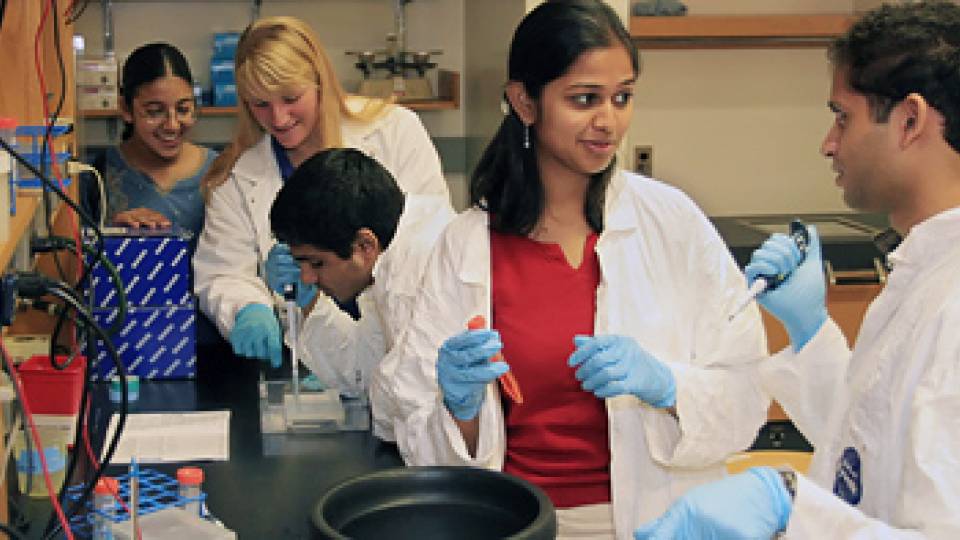In a step toward making living cells function as if they were tiny
computers, engineers at Princeton have programmed bacteria to
communicate with each other and produce color-coded patterns.
The feat, accomplished in a biology lab within the Department of Electrical Engineering,
represents an important proof-of-principle in an emerging field known
as "synthetic biology," which aims to harness living cells as
workhorses that detect hazards, build structures or repair tissues and
organs within the body.
"We are really moving beyond the ability to program individual cells to
programming a large collection -- millions or billions -- of cells to
do interesting things," said Ron Weiss, an assistant professor of electrical engineering and molecular biology.
Collaborating with researchers at the California Institute of
Technology, Weiss and graduate student Subhayu Basu programmed E. coli
bacteria to emit red or green fluorescent light in response to a signal
emitted from another set of E. coli. In one experiment, the cells
glowed green when they sensed a higher concentration of the signal
chemical and red when they sensed a lower concentration. In a Petri
dish, they formed a bull's-eye pattern -- a green circle inside a red
one -- surrounding the sender cells.
In addition to demonstrating that the genetic programming techniques
work, this sensing system could be useful for the detection of
chemicals or organisms in laboratory tests. "The bull's-eye could tell
you: This is where the anthrax is," said Weiss.
The researchers published their results in the April 28 issue of
Nature. In addition to Weiss and Basu, authors of the paper are
postdoctoral researcher Yoram Gerchman at Princeton and professor of
chemical engineering Frances Arnold and graduate student Cynthia
Collins at Caltech. It was funded by a grant from the U.S. Defense
Advanced Research Projects Agency.
In previous work, including a paper published March 8 in the
Proceedings of the National Academy of Sciences along with Sara
Hooshangi and Stephan Thiberge, Weiss showed the feasibility of
inserting engineered pieces of DNA into cells to make them behave in
the same manner as digital circuits. The cells, for example, could be
made to perform basic mathematical logic and produce crisp, reliable
readouts that are more commonly associated with silicon chips than
biological organisms. The new paper applies similar techniques to a
large population of cells.
"Here we're showing an integrated package where the cells have an
ability to send messages and other cells have the ability to act on
these messages," said Weiss.
The creation of patterns, such as the bull's-eye effect, is a key step
in one of Weiss' eventual goals, which is to have the cells secrete
materials that build physical devices such as antennas or transmitters
in places that are hard for humans to reach. Programmed cells also
could be used to control the repair or construction of tissues within
the body, possibly guiding stem cells to the locations where they are
needed for the growth of new nerve or bone cells in a process Weiss
called "programmed tissue engineering."
Even the early step of creating patterns in a Petri dish, however, may
be useful as a tool for other scientists, particularly developmental
biologists who are trying to understand how the cells of an embryo
arrange themselves into patterns that become the various body parts of
a mature organism. In fruit fly embryos, for example, the first cells
are thought to differentiate into the head, abdomen and other parts
based on the concentration of chemical signals that are emitted from
the ends of the embryo.
In addition to conducting laboratory experiments, Weiss and colleagues
are creating computer models of their engineered systems, which allow
them to study how small modifications would affect the ultimate
behavior of the organisms. So far, said Weiss, the experimental results
have matched the computer models fairly closely, but the goal is to
have a mathematically exact description of how each component works.
"One of the nice things about synthetic biology is that because we
built the network from scratch, we should be able to model all the
important details," he said. At some point in the future, he said,
scientists will be able to choose a behavior they want from cells, and
a computer program will create a genetic circuit to accomplish the
task. "Then we can do an experiment to see if the community of cells is
behaving as we desire. That is going to have a tremendous number of
applications."




